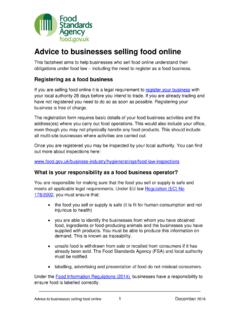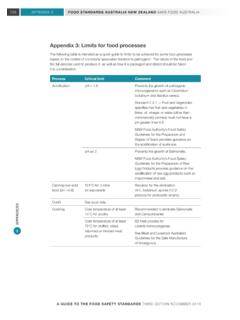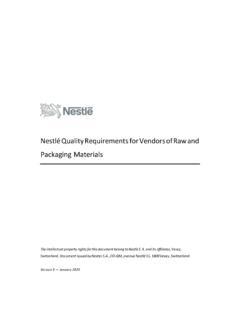Transcription of Environmental labelling and information schemes
1 POLICY PERSPECTIVESE nvironmental labelling and information schemesThe OECD has a long history of influencing the development of Environmental labels. Following the first report on Environmental labelling in 1976, extensive reviews of existing and planned schemes were carried out in the 1980s and into the 1990s, contributing to promoting their use and effectiveness. Later work turned to interactions of Environmental labelling and information schemes (ELIS) and international trade, notably from the late 1990s. Recent OECD work has focused on the multiplication of schemes , through a joint project of the Joint Working Party on Trade and Environment (JWPTE) and the Working Party on Integrating Environmental and Economic Policies (WPIEEP).
2 The joint project produced three reports since 2013, which form the basis for this synthesis report: The first report (Gru re, 2013) documented the scale and nature of this growth and multiplication . It provided a new characterisation of the many types of scheme and presented quantified growth trends. The report also mapped the complex and dynamic landscape of ELIS actors, including suppliers and users as well as other institutions and stakeholders involved in development and operation of schemes . A second strand of the work (Prag et al.)
3 , 2016) investigated the implications of the rapid growth of schemes around the world, notably for Environmental effectiveness and international trade. The report also considered responses to ELIS multiplication by government and non-government actors, as well as the implications of these responses for environment and trade. A third report (Klintman, 2016) centred on how public policies have guided and regulated ELIS, with a particular focus on self-made Environmental claims. This included a comparative analysis of guidelines and regulatory instruments examined definitions, standards, labelling requirements as well as monitoring and enforcement.
4 OECD work on Environmental labelling : past and present POLICY PERSPECTIVESWhat s in this synthesis report?WHAT S IN THIS SYNTHESIS REPORT? . 1 This synthesis report presents key findings from three recent OECD reports on Environmental labelling and information schemes (ELIS). While ELIS have been used for over forty years, recent growth has led to the family of ELIS now covering an increasingly wide set of policies and initiatives providing information to external users about one or more aspects of the Environmental performance of a product or service.
5 The first public eco- labelling schemes in the 1970s were designed to provide seals on products with the best Environmental characteristics. So-called single-issue certification schemes (tending to focus on particular Environmental issues, often in individual sectors) and various private standards followed in the 1980s and 1990s. The last fifteen years have seen a multiplication of ELIS of varying scope and nature, including the emergence of new types of schemes , notably quantitative footprint schemes for GHG and broader Environmental impact.
6 The current landscape of ELIS therefore goes beyond labels using a single seal or logo, also including diverse quantitative declarations and a wide variety of textual claims such as biodegradable , natural and sustainably sourced . ELIS now provide communication channels between business or government on the one hand and business, governments and consumers on the other. schemes involve either business-to-business (B2B) or business-to-consumer (B2C) communication, or both simultaneously. They are developed and managed by public agencies, private companies or non-profit organisations, individually or in partnership.
7 The growth in the overall number of schemes as well as the increasing complexity of the ELIS landscape has led to a number of policy-relevant questions emerging. These include whether the multiplication of schemes may have implications for the overall Environmental effectiveness of ELIS, whether multiplication has implications for international trade, and what policy responses might be appropriate. The recent OECD project aimed to explore these questions, and the key findings are summarised here. The growth of Environmental labelling and information schemes Facts and FiguresWhat are the different types of scheme?
8 Recognising the shortfalls of the widely-used ISO typology of labelling schemes , recent OECD work moved towards a broader categorisation that captures the wide variety of modern schemes (Box 1). schemes are characterised according to the type of communication they use and the nature of the standards on which they are based. 1 ELIS generally rely on one of three types of communication:1. The first category includes Environmental seals based on certification. While obtaining the seal may require sophisticated Environmental information about multiple Environmental areas, the information is provided in a simple, immediately visible A second category relies on complex reporting methods (such as comprehensive reports or footprinting) which are closer to Environmental audits and require more time for users to understand.
9 They focus on Environmental attributes that can be Intermediate schemes provide simplified semi-quantitative information , a multi-tier rating, so as to catch the eye of the user and yet enable a more advanced categorisation than a to the nature of the standards used, schemes can be characterised according to the ownership of the standard, notably whether they are private, public, non-profit or hybrid. The line between private and public schemes is increasingly being blurred as governments and non-profit organisations are involved in joint-ventures with private schemes , such as recent roundtable certification schemes which rely on partnerships between public and private sector important distinction is whether scheme are voluntary or mandatory in nature.
10 Mandatory schemes remain an exception (largely confined to energy efficiency labelling ), though some voluntary schemes include mandatory requirements that apply should a party choose to use the label. A further useful distinction is whether the scheme is self-setting or certified externally, and whether monitoring and auditing are carried out on a first-, second- or third-party basis. These criteria are often related: for instance self-set standards are often privately developed, voluntary, and first- or second- party audited.













